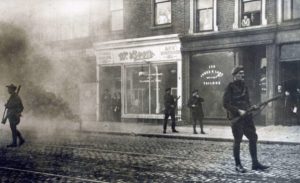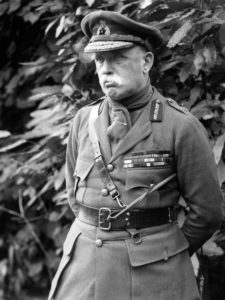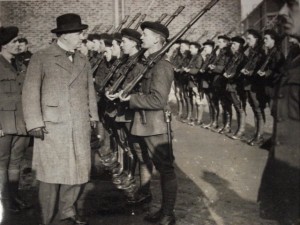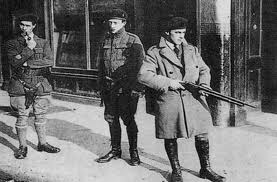The Black and Tans and Auxiliaries – An Overview

By Seán William Gannon
The recent public controversy over the planned state commemoration of the Royal Irish Constabulary (RIC) revealed widespread confusion over the relationships between the force’s constituent parts during the Irish War of Independence.
This was especially evident in the case of the Black and Tans, police constables recruited from January 1920 onwards in response to an escalating manpower crisis.
Who were the Black and Tans?

The ‘Black and Tans’ was a name applied to new recruits to the RIC in 1920 and 1921.
It derived from their initial makeshift uniform comprising combinations of military khaki and police black and dark green, though they were later kitted out in standard RIC uniforms.
The overwhelming majority of these recruits were British veterans of the Great War.
Contrary to popular opinion, they were not ‘temporary constables’, but recruited onto the RIC’s permanent, pensionable establishment on the same pay scale as the pre-1920 or ‘old’ RIC. [1]
The ‘Black and Tans’ were new recruits to the RIC in 1920 and 1921. They were not ‘temporary constables’ or a ‘special reserve’.
They were distributed across the country where they were barracked with and served alongside the ‘old RIC’ – they were in no sense a ‘special reserve’. In excess of 8,000 British and 2000 Irish permanent RIC constables were recruited in these two years.
The Black and Tans were not, as the the traditional nationalist narrative had it, ‘jailbirds and down-and-outs’. Those with a criminal record could not apply. The RIC registers of service and related records reveal, in the main, ordinary, everyday men[2].
The Auxiliary Division was a separate paramilitary force recruited into the RIC on short term contracts.
The term ‘Black-and-Tannery’ became a byword for police brutality and Black and Tans were indeed responsible for some of the gravest crimes of the Irish revolutionary period. But many of the atrocities popularly attributed to the Black and Tans were in fact carried out by the Auxiliary Division RIC (ADRIC).
This corps, formed in mid 1920, was, unlike the Black and Tans, separately recruited from the regular RIC. Recruitment was confined to ex-officers and it was organised into military style companies. The Auxiliaries were temporarily contracted and had the status of ‘temporary cadets’. Their drivers and logistical support personnel had the rank of ‘temporary constables’. Some 2,200 men saw service in the Auxiliary Division.
In the Irish public mind, however both new RIC recruits and Auxiliaries became conflated as ‘Black and Tans’.
The RIC in crisis

What caused the British authorities to recruit demobilised soldiers into the Irish police?
The decision to recruit British ex-servicemen into the RIC in 1920 had its roots in the force’s incremental alienation within Irish society after 1916. The force had maintained generally difficult relations with the population it policed throughout the nineteenth century, when it formed Dublin Castle’s main coercive arm.
The of influx pf British ex-servicemen into the RIC in 1920 was result of a manpower crisis and demoralisation within the force.
But, by the the turn of the twentieth century, it was evolving into a relatively ‘domesticated’ force, devoting most of its time to civil matters such as checking weights and measures, policing road traffic, and collecting the census.
But the RIC continued political surveillance, and arrested separatist activists, so the upsurge in nationalist sentiment in the aftermath of the Easter Rising saw its gradual estrangement from the communities in which it served.
This estrangement gained pace after the First Dáil’s declaration of Irish independence in January 1919 and was officialised by its president, Éamon de Valera, on 10 April when he denounced the RIC as agents of the ‘foreign usurper’ whose ‘history [was] a continuity of brutal treason against their own people’. This marked the beginning of a two-year campaign of social ostracism against the force by Sinn Féin, which was so intense and effective that it has been termed a ‘social war’.[3]
The RIC also found themselves placed in the IRA’s crosshairs. The War of Independence opened with the shooting dead of two constables at Soloheadbeg on 21 January 1919 by members of the 3rd Tipperary Brigade and the RIC afterwards formed the frontline against a gathering guerrilla insurgency it was untrained, unequipped, and otherwise unsuited to counter. By December, a further 11 policemen were dead (together with one British Army soldier and 7 IRA Volunteers).

The progressive demoralisation in which the RIC’s deteriorating situation resulted led to resignations, as fearful for themselves and their families, policemen left or were intimidated out. Recruitment was also adversely affected, and it became increasingly difficult to replace those who resigned or retired, which in 1919 amounted to some 12 percent of the force.
The manpower crisis to which this gave rise peaked in summer 1920 when there was an average of 52 resignations and just 7 enlistments per week. But it was sufficiently clear by the late autumn of 1919 that recruitment in Ireland was irrecoverably compromised.
As early as May 1919, the First Lord of the Admiralty, Walter Long, was urging Ireland’s viceroy, Lord John French, to use demobilised British soldiers to bolster the RIC.
Despite the misgivings of the force’s inspector-general, Joseph Byrne, who warned (prophetically) that ex-soldiers would not be amenable to police discipline, French agreed to Long’s suggestion. Byrne, increasingly seen by Long and French as soft on Sinn Féin, was eventually removed from his post and replaced with his deputy, T. J. Smith, who supported the recruitment of ex-soldiers.
The Black and Tans
On 27 December, Dublin Castle authorised the extension of RIC recruitment to Britain. Offices were immediately opened in London, Liverpool, and Glasgow and the first British constables were enrolled on 2 January 1920.
About 8,000 British and 2,000 Irish constables were recruited into the RIC in 1920 and 1921, the name Black and Tans came from their makeshift initial uniform.
Initially, the uptake was modest, comprising a monthly average of 100 enlistments between January and June. However, the doubling of an RIC constable’s starting salary in July led to a upsurge in interest, resulting in over 8,000 British and 2,000 Irish enlistments in the subsequent twelve months.
Small detachments of so-called ‘English recruits’ began arriving in Ireland from 7 January. After cursory training in the Phoenix Park depot, they were distributed around the country where they were barracked with and served alongside the ‘old RIC’ . Although there was no formal distinction between them, the appearance of what the Meath Chronicle termed this ‘Royal English Constabulary’ soon caused a stir, not least because of its peculiar attire.[4]
As existing stocks of the standard RIC uniform were insufficient to the numbers enlisting, early recruits were largely clad out in combinations of army khaki and police rifle green (which could, from a distance, look black), together with RIC-issue black greatcoats and caps.
The ‘Black and Tan’ moniker, to which this makeshift uniform gave rise, was said by the RIC’s Weekly Summary to have originated in Limerick, where the black and brown coat pattern of the Scarteen hunt’s Kerry beagles had earned them the same nickname.[5]
The Auxiliaries

The continuance of the IRA’s campaign despite the RIC’s reinforcement led to calls for a clear counterinsurgency strategy and, reluctant to use the army, the secretary of state for war, Winston Churchill, proposed the formation of a separately recruited emergency ‘corps of gendarmerie’ to root out and neutralise the IRA.
The result was the Auxiliary Division of the RIC (ADRIC), raised from July 1920 from amongst demobilised officers. Pay was particularly attractive (at £1 a day, base pay was double that of the regular RIC and supplemented with generous allowances) but, unlike in the case of the permanent, pensionable Black and Tans, recruits were temporarily contracted, mostly for one year.
The Auxiliaries, unlike the Black and Tans, were separately recruited from the regular RIC. Recruitment was confined to ex-officers and it was organised into military style companies.
The ADRIC eventually comprised 21 military-style companies comprising 70 to 100 ‘Temporary Cadets’. These companies were deployed in areas of significant insurgent activity where, while nominally under the control of RIC county inspectors and divisional commissioners, they essentially operated autonomously.
Logistical assistance was provided the ADRIC by a separately recruited 1,000-strong Veterans and Drivers Division, made up of ‘veteran ex-soldiers of 35 years of age and upwards’ enrolled on one-year contracts at 10 shillings per day: these, and another 1,500 men recruited for the RIC’s motor division, were the actual ‘Temporary Constables’ rather than the ‘Black and Tan’ recruits to the RIC.
The Auxiliaries did not have a standard uniform and they turned themselves out in various combinations of police, military, and (occasionally) civilian attire, although they were distinguished from Black and Tans by their beret-style headress – ‘tam o’shanters’ and, later, ‘balmorals’.
Confusion between the Black and Tans and Auxiliaries was widespread in Ireland and Britain, including at the highest levels of government.
Irish chief secretary, Sir Hamar Greenwood, eventually issued a clarification in parliament: ‘The so-called Black-and-Tans are not a separate force, but are recruits to the permanent establishment of the [RIC]. The Auxiliary Division is also a part of the [RIC], but consists altogether of ex-officers … who have been recruited for temporary service only’.[6]
Nonetheless, British officials, including Churchill himself, used the terms ‘Auxiliaries’, ‘Auxiliary Division’, and ‘Black and Tans’ interchangeably when referring to the two groups combined.
‘An appropriate hell ’ – atrocities and reprisals

In late August 1920, the Weekly Summary warned that the Black and Tans would make Ireland ‘an appropriate hell for those whose trade is agitation and whose method is murder’ and they were primarily responsible for some of the gravest crimes of the Irish revolutionary period, including murders, burning, looting, and sexual assaults.[7]
Yet, in terms of brutality, they paled by comparison with the ADRIC, which actually carried out many of the atrocities for which the Black and Tans are routinely blamed, such as the murders of Eileen Quinn and Harry and Patrick Loughnane in south Galway in November 1920, the burning of Cork two weeks later, and the March 1921 ‘Curfew murders’ in Limerick. ‘Old RIC’ crimes are also frequently attributed to the Black and Tans, most notably the murder of Cork lord mayor, Tomás Mac Curtain.
The Auxiliaries actually carried out many of the atrocities for which the Black and Tans are routinely blamed
The traditional nationalist narrative of police violence in revolutionary Ireland is that it derived from the low moral character of British RIC recruits and their brutalization by the Great War.
But recent research has exploded the notion that these men were ‘jailbirds and down-and-outs’, ‘dirty tools for a dirty job’, ‘the scum of London’s underworld’ and so forth while, in the absence of detailed information on their personal wartime experiences, the brutalization theory is just that – a theory.
In actuality, the frequent savagery of the Black and Tans, particularly reprisals, was largely a function of the situation into which they were thrust. David Leeson argued:
Terrorised by the guerrillas and shunned by the people: enraged by the deaths of their comrades, and inflamed by drink; incited by their officers, and encouraged by faint official censure – the police took to reprisals as a form of rough justice.
‘Even ordinary men’, David Leeson observed, ‘would have committed atrocities under circumstances like these’.
Between January 1919 and the Truce of 11 July 1921, some 428 RIC personnel were killed and more than 700 wounded. Just over half of those killed were Black and Tans and Auxiliaries. [8]
Disbandment

Mainly (although by no means entirely) on account of its misconduct, the RIC became a casualty of the Anglo-Irish peace. Its disbandment commenced in January 1922 and concluded on 31 August. The Auxiliaries were first stood down, followed (broadly speaking) by the Black and Tans, and finally the ‘old RIC’.
Auxiliaries were ineligible for pensions on account of their temporary status: they received balances due on unexpired contracts, many of which had been cut short by the RIC’s peremptory demise.
Many Black and Tans ended up unemployed when the RIC was disbanded.
Meanwhile, the RIC’s permanent establishment (both the ‘old RIC’ and Black and Tans) were granted a compensation package deemed the most generous ever offered to departing Crown servants: pensions were calculated on length of service plus twelve years and provision was made for loading and commutation. Broadly speaking, ‘old RIC’ pensions were paid by the Free State, those of Black and Tans by the UK.
A small number along with a larger number of old RIC officers ended up in the Royal Ulster Constabulary.
Nonetheless, all but the longer serving men still required work, particularly the Black and Tans who, by definition, had a maximum of just two years actual service. It had been hoped that UK constabularies would take many on but, apart from the Northern Ireland’s new Royal Ulster Constabulary (RUC) which had enrolled 1,347 ex-RIC by October 1922 (including over 250 Black and Tans and Auxiliaries), they displayed a marked disinclination to recruit former members of a by then internationally notorious outfit.
This disinclination was shared by UK businesses and firms and former Black and Tans were quickly complaining that ‘it tells against them when they mention their last employment’ when looking for work. British firms with Irish employees were reported to be especially reluctant to hire them, fearing fallout on the shop floor.
In March 1922, angry Black and Tans held a series of demonstrations in London to publicize their grievances, with onlookers described as being ‘as little sympathetic as the employers’. This, coupled with delays in the processing of RIC pensions, meant that 3000 such men were reportedly in need of financial assistance, with several said to be destitute.[9]
After Ireland
Most disbanded British Black and Tans ultimately returned to the working class they had left for the Great War. But a significant number opted for imperial migration, particularly to Canada where a number of private land settlement schemes were directly targeting ex-RIC constables.[10]
Nearly 700 former Black and Tans and Auxiliaries joined the British Palestine Mandate police in 1922.
In addition, 480 or so Black and Tans and 160 former Auxiliaries transferred to the British Palestine Mandate in April 1922 as part of a newly raised gendarmerie-style striking force. They were there joined by Irish police chief, Major-General Hugh Tudor, who assumed the position of Palestine’s General Officer Commanding and Inspector-General of Police and Prisons in June.
The crimes of the Black and Tans and Auxiliaries saw the term ‘Black-and-Tannery’ become a twentieth-century byword for extreme police brutality in Ireland elsewhere and it remains so today. In fact, as the commemoration controversy clearly demonstrated, the ‘Black and Tans’ have assumed the status of a national cultural trope.
Seán William Gannon is a historian of Modern Ireland, the British empire, and their intersections. His book: The Irish imperial service: policing Palestine and administering the empire, is published by Palgrave MacMillan.
References
[1] Hansard, House of Commons Debates, 138/1307W, 25 Feb. 1921
[2] The average British RIC constable was an unmarried working-class Anglican in his mid-twenties from London or its environs.
[3] Dáil Éireann Debates, 10 Apr. 1919, vol. F, no. 6 c67; Charles Townshend, The Republic: the fight for Irish indepenence (London, 2013), p. 29.
[4] Meath Chronicle, 28 Feb. 1920.
[5] Weekly Summary, 15 Apr. 1921.
[6] Hansard, House of Commons Debates, 138/1307W, 25 Feb. 1921
[7] Weekly Summary, 27 Aug. 1920.
[8] D. M. Leeson, The Black and Tans: British police and auxiliaries in the Irish War of Independence (Oxford, 2011), pp. 191, p. 224. For RIC casualties see Richard Abbot Police Casualties in Ireland 1919-1922 (2019). In addition several dozen more police, including members of the Ulster Special Constabulary, were killed after the truce in late 1921 and early 1922.
[9] Cork Examiner, 13 Mar. 1922; Evening Telegraph, 7 Mar. 1922. For the figures on ex RIC men joining the Royal Ulster Constabulary, see UK National Archives, Treasury files T 160/25, Trickett, ‘Disbandment of R.I.C.: Cost of Compensation Allowances’, 5 Oct. 1922. The figure of 1,347 included the Ulster Special COnstabulary. The figure for the RUC ‘proper’ was c. 1,250
[10] The precise number who migrated is difficult to gauge. But the RIC Resettlement Branch reported that 372 ex-RIC had decided to do so by February 1922 and a total of 1,436 had left under its auspices by December 1923. Kent Fedorowich estimated that a further 500 probably followed in subsequent short-term. Kent Fedorowich, ‘The problems of disbandment: the Royal Irish Constabulary and imperial migration’, Irish Historical Studies, 30 (1996), pp. 88-110, at pp. 105-107.